







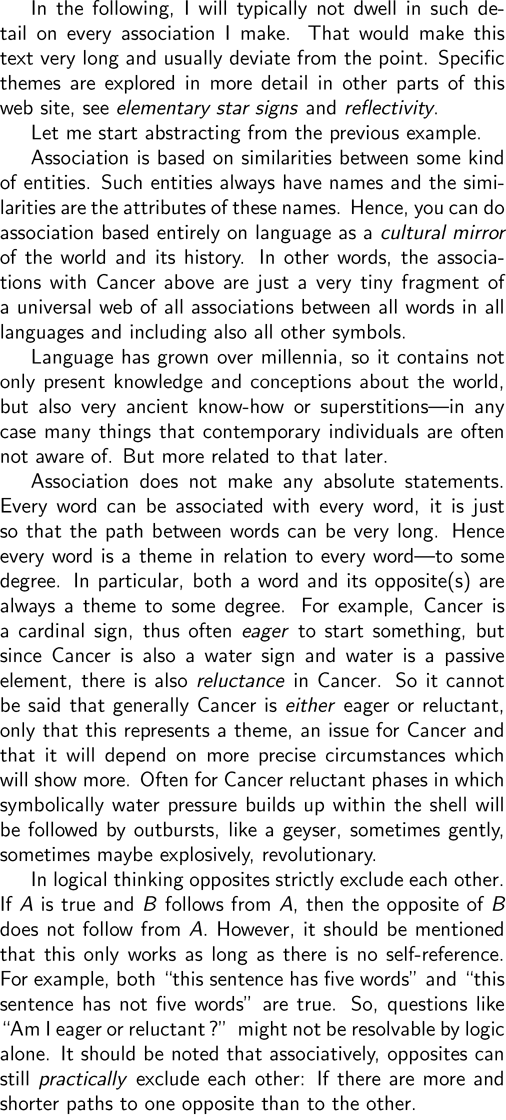
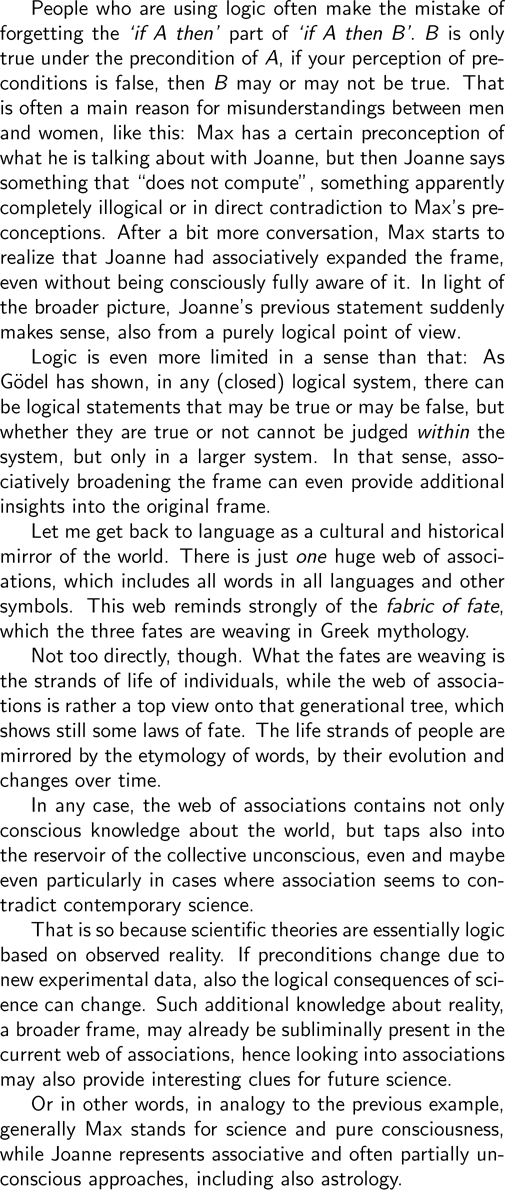

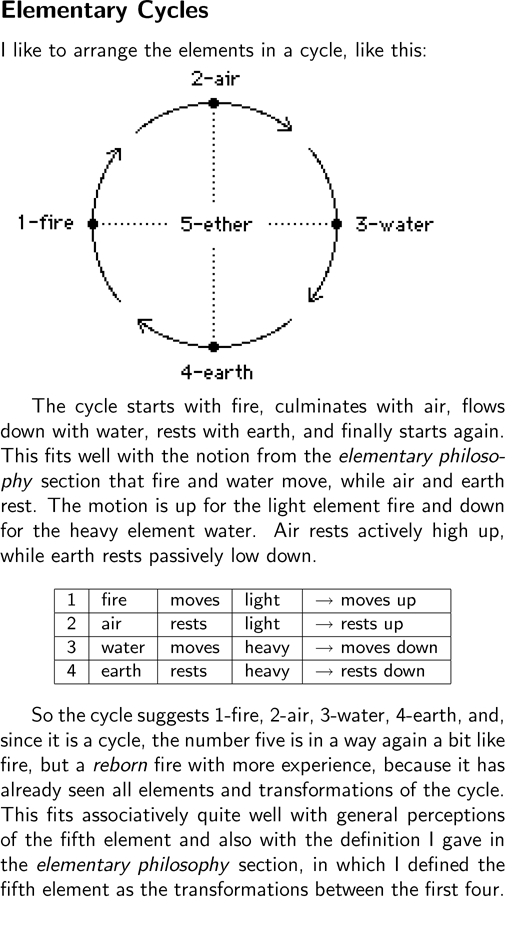
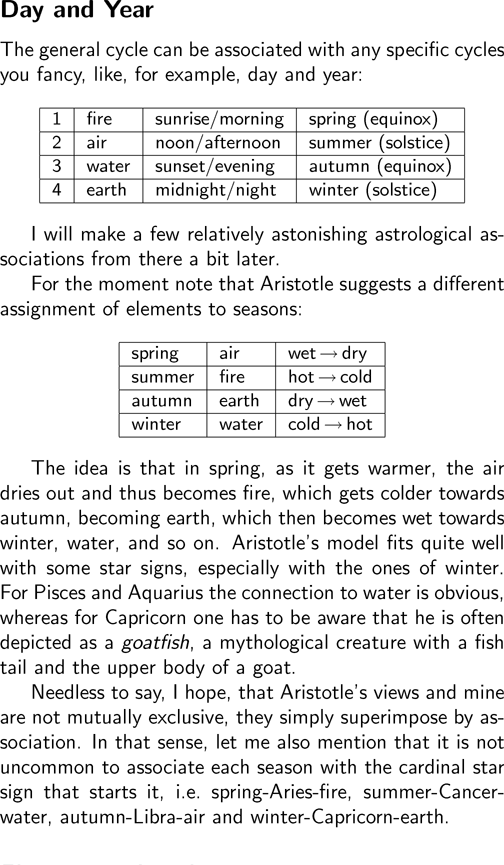
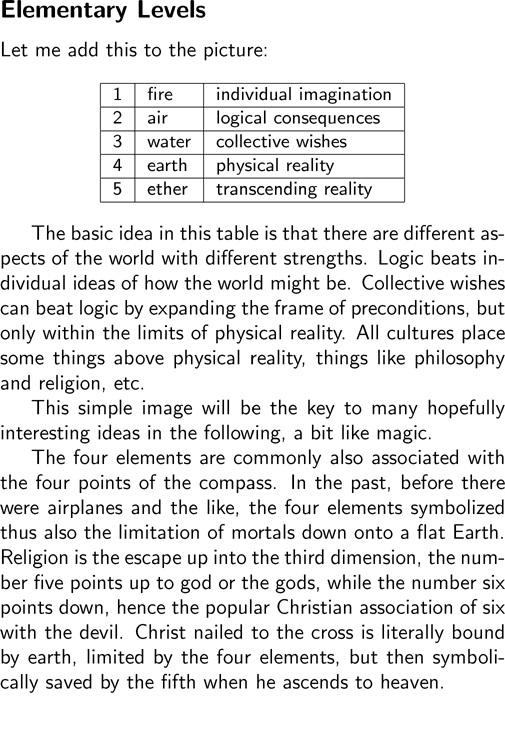

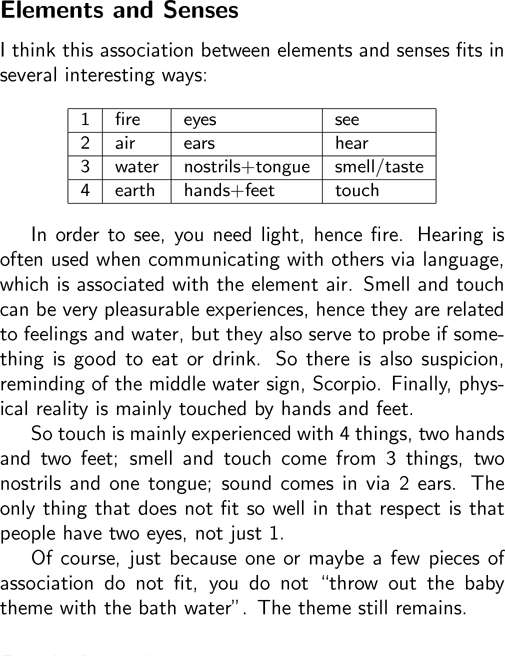
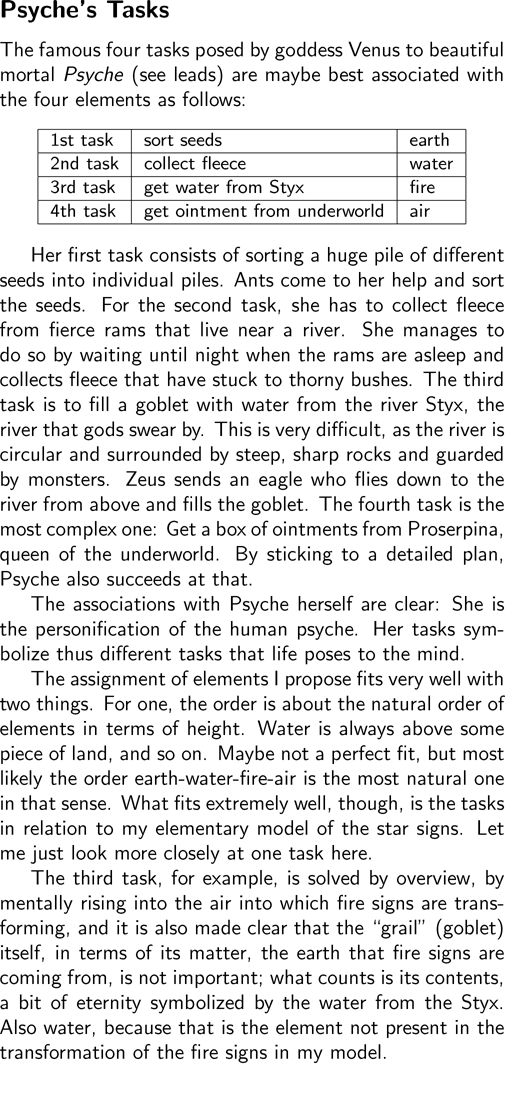

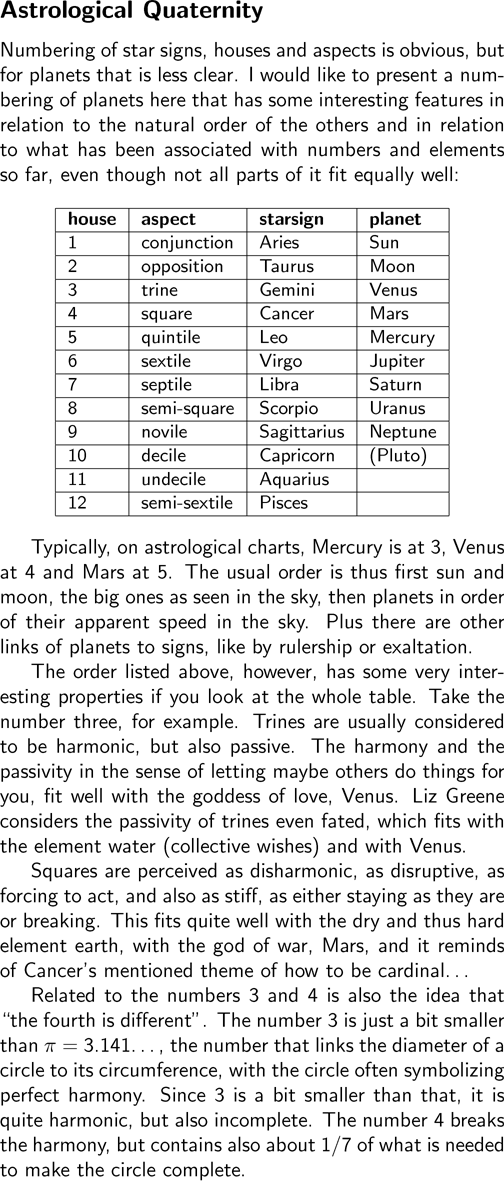

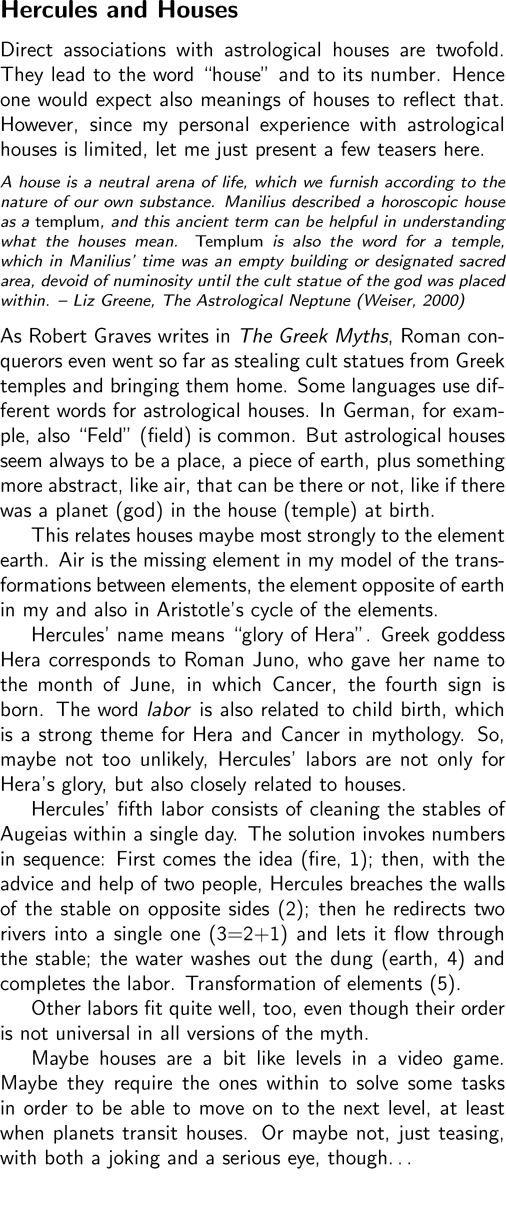
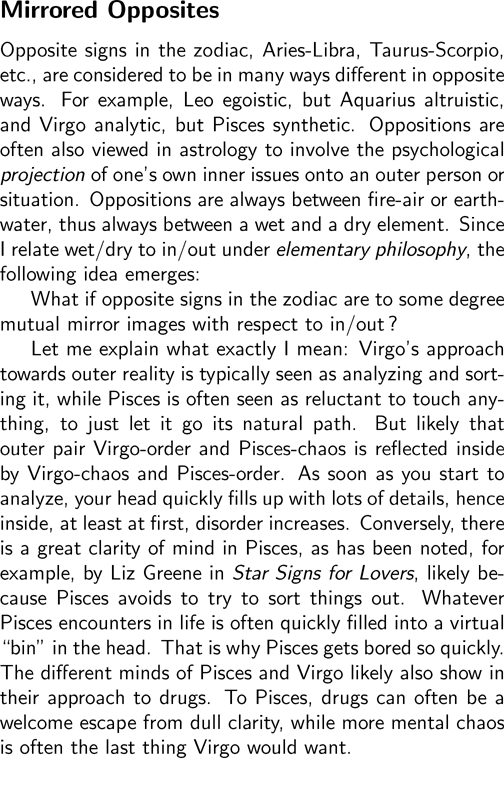
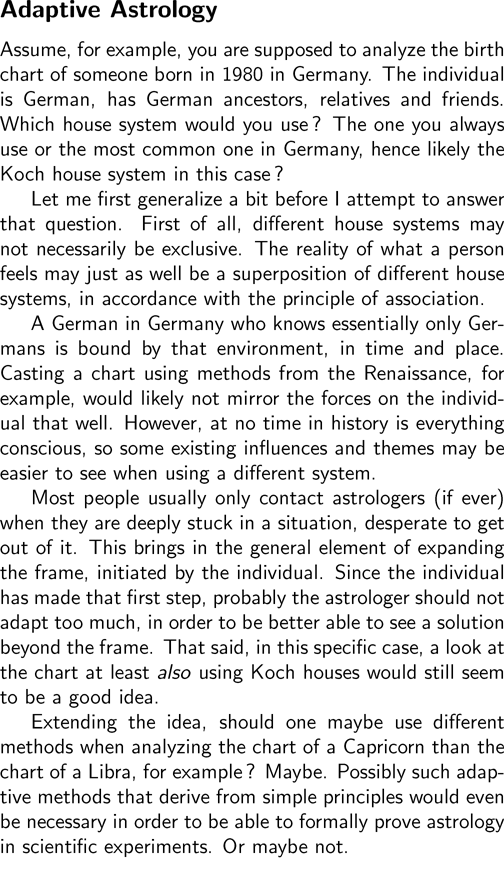
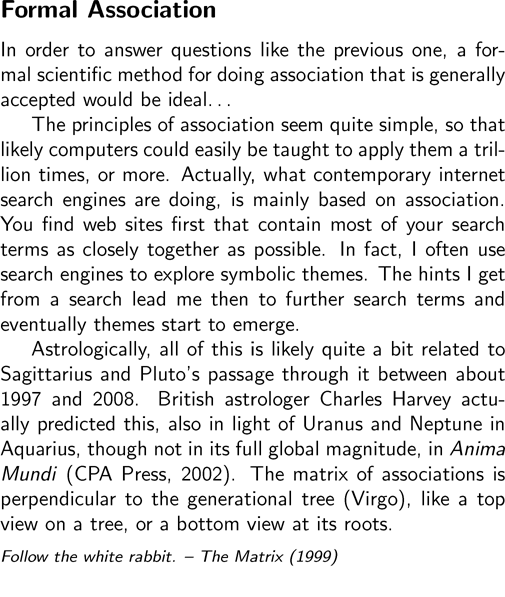

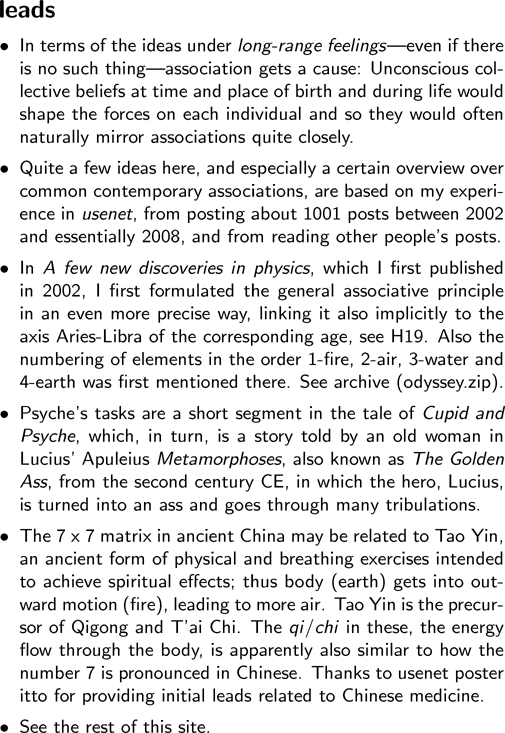



|
|

|
                         |
|
|
magic carpetsHow logic and association can be used to creatively explore symbolic systems, like astrology, in a fairly structured and controlled way. Presents lots of new cool examples, mostly related to Western tropical astrology, but the method would be generally useful and could likely be formalized... Association and LogicHere are a few associations with the star sign Cancer: [image] Cancer is the latin word for crab, which leads to the hard shell (but soft inside) of the animal, the "house" that some crabs are carrying around for protection, the water and sea it lives in or nearby, and from sea you get to tides and to sun and moon which cause tides; Cancer also leads to the moon as the astrological planet who rules Cancer, and, because Cancer is the fourth star sign of the zodiac, to the fourth astrological house, which is often related to mother and father, who are generally associated with moon and sun, respectively. These few paths reveal already several themes related to Cancer. A theme is essentially just a word or a group of words that is relatively close to the starting point (Cancer in this example) and to which several independent paths lead. Protection would be a theme, since you can get there from house and shell. Or water, because Cancer is a water sign and the animal lives in or near water. And, maybe a bit astonishingly to some astrologers at first sight, sun starts to emerge also as a theme for Cancer. Liz Greene recognizes the sun theme for Cancer in The Astrology of Fate (Weiser, 1984). In ancient Egypt, the star sign Cancer was a beetle and it was "equated with the creator god Atum, a form of the sun god because the beetle pushes its dung-ball before it as Atum pushes the solar ball across the sky". And a bit later: "The cusp of the fourth house [...] has long been associated with the end of life; here it is also imagined as the beginning, for this is the point of the sun at midnight when the old day dies and the new day is born [...] This deeply mystical linking of Cancer with the very seed of life connects it not only with the primordial mother, but with the Father as well [...]". In the following, I will typically not dwell in such detail on every association I make. That would make this text very long and usually deviate from the point. Specific themes are explored in more detail in other parts of this web site, see elementary star signs and reflectivity. Let me start abstracting from the previous example. Association is based on similarities between some kind of entities. Such entities always have names and the similarities are the attributes of these names. Hence, you can do association based entirely on language as a cultural mirror of the world and its history. In other words, the associations with Cancer above are just a very tiny fragment of a universal web of all associations between all words in all languages and including also all other symbols. Language has grown over millennia, so it contains not only present knowledge and conceptions about the world, but also very ancient know-how or superstitions - in any case many things that contemporary individuals are often not aware of. But more related to that later. Association does not make any absolute statements. Every word can be associated with every word, it is just so that the path between words can be very long. Hence every word is a theme in relation to every word - to some degree. In particular, both a word and its opposite(s) are always a theme to some degree. For example, Cancer is a cardinal sign, thus often eager to start something, but since Cancer is also a water sign and water is a passive element, there is also reluctance in Cancer. So it cannot be said that generally Cancer is either eager or reluctant, only that this represents a theme, an issue for Cancer and that it will depend on more precise circumstances which will show more. Often for Cancer reluctant phases in which symbolically water pressure builds up within the shell will be followed by outbursts, like a geyser, sometimes gently, sometimes maybe explosively, revolutionary. In logical thinking opposites strictly exclude each other. If A is true and B follows from A, then the opposite of B does not follow from A. However, it should be mentioned that this only works as long as there is no self-reference. For example, both "this sentence has five words" and "this sentence has not five words" are true. So, questions like "Am I eager or reluctant?" might not be resolvable by logic alone. It should be noted that associatively, opposites can still practically exclude each other: If there are more and shorter paths to one opposite than to the other. People who are using logic often make the mistake of forgetting the 'if A then' part of 'if A then B'. B is only true under the precondition of A, if your perception of preconditions is false, then B may or may not be true. That is often a main reason for misunderstandings between men and women, like this: Max has a certain preconception of what he is talking about with Joanne, but then Joanne says something that "does not compute", something apparently completely illogical or in direct contradiction to Max's preconceptions. After a bit more conversation, Max starts to realize that Joanne had associatively expanded the frame, even without being consciously fully aware of it. In light of the broader picture, Joanne's previous statement suddenly makes sense, also from a purely logical point of view. Logic is even more limited in a sense than that: As Göodel has shown, in any (closed) logical system, there can be logical statements that may be true or may be false, but whether they are true or not cannot be judged within the system, but only in a larger system. In that sense, associatively broadening the frame can even provide additional insights into the original frame. Let me get back to language as a cultural and historical mirror of the world. There is just one huge web of associations, which includes all words in all languages and other symbols. This web reminds strongly of the fabric of fate, which the three fates are weaving in Greek mythology. Not too directly, though. What the fates are weaving is the strands of life of individuals, while the web of associations is rather a top view onto that generational tree, which shows still some laws of fate. The life strands of people are mirrored by the etymology of words, by their evolution and changes over time. In any case, the web of associations contains not only conscious knowledge about the world, but taps also into the reservoir of the collective unconscious, even and maybe even particularly in cases where association seems to contradict contemporary science. That is so because scientific theories are essentially logic based on observed reality. If preconditions change due to new experimental data, also the logical consequences of science can change. Such additional knowledge about reality, a broader frame, may already be subliminally present in the current web of associations, hence looking into associations may also provide interesting clues for future science. Or in other words, in analogy to the previous example, generally Max stands for science and pure consciousness, while Joanne represents associative and often partially unconscious approaches, including also astrology. Let me leave it at that and present a few of my favorite associations, many related to western astrology, but some also related to association itself. Many of them will help to form a simple toolbox that I will then apply to various topics in the reflectivity section. Note that - obviously in light of what has been said so far - none of these ideas is intended to be exclusive with already existing common associations. Many of them are simpler approaches to associations that are already widely recognized. Others are just minor complementary views, which can maybe help to complete a theme or might only be suitable in specific situations. Often I will quickly mention corresponding mainstream associations, too. Elementary CyclesI like to arrange the elements in a cycle, like this: [image] The cycle starts with fire, culminates with air, flows down with water, rests with earth, and finally starts again. This fits well with the notion from the elementary philosophy section that fire and water move, while air and earth rest. The motion is up for the light element fire and down for the heavy element water. Air rests actively high up, while earth rests passively low down.
So the cycle suggests 1-fire, 2-air, 3-water, 4-earth, and, since it is a cycle, the number five is in a way again a bit like fire, but a reborn fire with more experience, because it has already seen all elements and transformations of the cycle. This fits associatively quite well with general perceptions of the fifth element and also with the definition I gave in the elementary philosophy section, in which I defined the fifth element as the transformations between the first four. Day and YearThe general cycle can be associated with any specific cycles you fancy, like, for example, day and year:
I will make a few relatively astonishing astrological associations from there a bit later. For the moment note that Aristotle suggests a different assignment of elements to seasons:
The idea is that in spring, as it gets warmer, the air dries out and thus becomes fire, which gets colder towards autumn, becoming earth, which then becomes wet towards winter, water, and so on. Aristotle's model fits quite well with some star signs, especially with the ones of winter. For Pisces and Aquarius the connection to water is obvious, whereas for Capricorn one has to be aware that he is often depicted as a goatfish, a mythological creature with a fish tail and the upper body of a goat. Needless to say, I hope, that Aristotle's views and mine are not mutually exclusive, they simply superimpose by association. In that sense, let me also mention that it is not uncommon to associate each season with the cardinal star sign that starts it, i.e. spring-Aries-fire, summer-Cancer-water, autumn-Libra-air and winter-Capricorn-earth. Elementary LevelsLet me add this to the picture:
The basic idea in this table is that there are different aspects of the world with different strengths. Logic beats individual ideas of how the world might be. Collective wishes can beat logic by expanding the frame of preconditions, but only within the limits of physical reality. All cultures place some things above physical reality, things like philosophy and religion, etc. This simple image will be the key to many hopefully interesting ideas in the following, a bit like magic. The four elements are commonly also associated with the four points of the compass. In the past, before there were airplanes and the like, the four elements symbolized thus also the limitation of mortals down onto a flat Earth. Religion is the escape up into the third dimension, the number five points up to god or the gods, while the number six points down, hence the popular Christian association of six with the devil. Christ nailed to the cross is literally bound by earth, limited by the four elements, but then symbolically saved by the fifth when he ascends to heaven. Ancient China and TransformationLet me associatively derive some very interesting properties of the numbers 6 to 10 from the smaller numbers. In my model of the star signs, fire signs, for example, are stages in the transition earth-fire-air. If you add the corresponding numbers, you get 4+1+2 = 7. This provides an association between the number 7 and the transformation of fire. If you do the same for all four elements, you get:
This strange way of associating things may seem "out of bounds" to some readers, but no association is wrong. And if you have the courage to look further, you can find this very astonishing correlation with Chinese themes:
There is a strong association with water in the 81 short texts of the Tao Te Ching. The I Ching, in contrast, is more structured, more earthy. And its subtitle Book of Changes links it explicitly to transformation. But there is more. In ancient China, it was apparently common that the land of farmers was arranged in a 3 x 3 matrix:
The outer 8 fields were cultivated by individual families, while the ninth central field was common property and contained the well. The Chinese word for well is very similar to the "ching" in I Ching and Tao Te Ching. So the well provides water (collective wishes) to the collective, making the outer fields (earth) fertile. The 36 Stratagems may be less known. They provide a concrete list of tactical and strategical advice how to win in battles. The logic (air) of war. I am not aware of anything that comes in 49 = 7 x 7 parts in ancient China. Elements and SensesI think this association between elements and senses fits in several interesting ways:
In order to see, you need light, hence fire. Hearing is often used when communicating with others via language, which is associated with the element air. Smell and touch can be very pleasurable experiences, hence they are related to feelings and water, but they also serve to probe if something is good to eat or drink. So there is also suspicion, reminding of the middle water sign, Scorpio. Finally, physical reality is mainly touched by hands and feet. So touch is mainly experienced with 4 things, two hands and two feet; smell and touch come from 3 things, two nostrils and one tongue; sound comes in via 2 ears. The only thing that does not fit so well in that respect is that people have two eyes, not just 1. Of course, just because one or maybe a few pieces of association do not fit, you do not "throw out the baby theme with the bath water". The theme still remains. Psyche's TasksThe famous four tasks posed by goddess Venus to beautiful mortal Psyche (see leads) are maybe best associated with the four elements as follows:
Her first task consists of sorting a huge pile of different seeds into individual piles. Ants come to her help and sort the seeds. For the second task, she has to collect fleece from fierce rams that live near a river. She manages to do so by waiting until night when the rams are asleep and collects fleece that have stuck to thorny bushes. The third task is to fill a goblet with water from the river Styx, the river that gods swear by. This is very difficult, as the river is circular and surrounded by steep, sharp rocks and guarded by monsters. Zeus sends an eagle who flies down to the river from above and fills the goblet. The fourth task is the most complex one: Get a box of ointments from Proserpina, queen of the underworld. By sticking to a detailed plan, Psyche also succeeds at that. The associations with Psyche herself are clear: She is the personification of the human psyche. Her tasks symbolize thus different tasks that life poses to the mind. The assignment of elements I propose fits very well with two things. For one, the order is about the natural order of elements in terms of height. Water is always above some piece of land, and so on. Maybe not a perfect fit, but most likely the order earth-water-fire-air is the most natural one in that sense. What fits extremely well, though, is the tasks in relation to my elementary model of the star signs. Let me just look more closely at one task here. The third task, for example, is solved by overview, by mentally rising into the air into which fire signs are transforming, and it is also made clear that the "grail" (goblet) itself, in terms of its matter, the earth that fire signs are coming from, is not important; what counts is its contents, a bit of eternity symbolized by the water from the Styx. Also water, because that is the element not present in the transformation of the fire signs in my model. Angles and SeasonsLet me map my cycle of the elements as applied to day and year to corresponding astrological concepts:
The ascendent is typically associated with the outer visual appearance of a person, with what you can immediately see, hence fire. In contrast, the medium coeli, the zenith, is often considered to be related to the public image of a person, to how you are perceived by people who do not know you in person. At least in the past, before television, a public image was typically conveyed by what you said and what you wrote. Hence the MC is more abstract than the AC, and, of course, this fits well with the element air. Astrological QuaternityNumbering of star signs, houses and aspects is obvious, but for planets that is less clear. I would like to present a numbering of planets here that has some interesting features in relation to the natural order of the others and in relation to what has been associated with numbers and elements so far, even though not all parts of it fit equally well:
Typically, on astrological charts, Mercury is at 3, Venus at 4 and Mars at 5. The usual order is thus first sun and moon, the big ones as seen in the sky, then planets in order of their apparent speed in the sky. Plus there are other links of planets to signs, like by rulership or exaltation. The order listed above, however, has some very interesting properties if you look at the whole table. Take the number three, for example. Trines are usually considered to be harmonic, but also passive. The harmony and the passivity in the sense of letting maybe others do things for you, fit well with the goddess of love, Venus. Liz Greene considers the passivity of trines even fated, which fits with the element water (collective wishes) and with Venus. Squares are perceived as disharmonic, as disruptive, as forcing to act, and also as stiff, as either staying as they are or breaking. This fits quite well with the dry and thus hard element earth, with the god of war, Mars, and it reminds of Cancer's mentioned theme of how to be cardinal... Related to the numbers 3 and 4 is also the idea that "the fourth is different". The number 3 is just a bit smaller than π = 3.141..., the number that links the diameter of a circle to its circumference, with the circle often symbolizing perfect harmony. Since 3 is a bit smaller than that, it is quite harmonic, but also incomplete. The number 4 breaks the harmony, but contains also about 1/7 of what is needed to make the circle complete. Planet Mercury is on average retrograde during about one 5th of the time. And its association with transformation is close to the fifth element. Quintiles are often related to creativity and talent, themes also prominent for Leo and the fifth house, and so on. (I found this order of planets a few years ago with an internet search and on that site it said that this had been the order commonly used in the past, but I could not find this site again afterwards, nor any other source that would use this order, Thus I am not sure if what that site said is true. As a meta association, this fits five and Mercury, like a glove. Gloves are for hands, which have 5 fingers, and hands are in astrology commonly associated with the star sign Gemini, which is ruled by Mercury, etc.) The fit for these three planets is not perfect, though. Especially Gemini-3 seems not to fit well. Gemini is ruled by Mercury, who helped the fates to create the alphabet. Fate comes from fatum, spoken. Hence language and communication have a fated angle, too, but I have never seen someone associate Gemini with harmony. Of course, a lot more associations could be made from these three numbers alone, not to speak of the others. Let me just mention something with regard to the numbers 8 and 9, before moving on. Neptune rules the sea (water), and Uranus is an earthy Titan in mythology, married to his mother Gaia ('Earth'), even though there is some ambivalence with regard to the other element in both gods. But there is also another concept from astrology that can be linked to 8 and 9. Before the discoveries of Uranus and Neptune, the only other 'object' besides the seven planets that was shown in birth charts was typically the lunar nodes, the points where the apparent path of the moon crosses the ecliptic (and they still appear on almost every chart drawn today). So, it makes sense to place them after Saturn, at positions 8 and 9. This association suggests a strong correlation between 8 and 9, stronger than, say, between 9 and 10, which fits also well with the Chinese associations I made previously. Hercules and HousesDirect associations with astrological houses are twofold. They lead to the word "house" and to its number. Hence one would expect also meanings of houses to reflect that. However, since my personal experience with astrological houses is limited, let me just present a few teasers here. A house is a neutral arena of life, which we furnish according to the nature of our own substance. Manilius described a horoscopic house as a templum, and this ancient term can be helpful in understanding what the houses mean. Templum is also the word for a temple, which in Manilius' time was an empty building or designated sacred area, devoid of numinosity until the cult statue of the god was placed within. -- Liz Greene, The Astrological Neptune (Weiser, 2000) As Robert Graves writes in The Greek Myths, Roman conquerors even went so far as stealing cult statues from Greek temples and bringing them home. Some languages use different words for astrological houses. In German, for example, also "Feld" (field) is common. But astrological houses seem always to be a place, a piece of earth, plus something more abstract, like air, that can be there or not, like if there was a planet (god) in the house (temple) at birth. This relates houses maybe most strongly to the element earth. Air is the missing element in my model of the transformations between elements, the element opposite of earth in my and also in Aristotle's cycle of the elements. Hercules' name means "glory of Hera". Greek goddess Hera corresponds to Roman Juno, who gave her name to the month of June, in which Cancer, the fourth sign is born. The word labor is also related to child birth, which is a strong theme for Hera and Cancer in mythology. So, maybe not too unlikely, Hercules' labors are not only for Hera's glory, but also closely related to houses. Hercules' fifth labor consists of cleaning the stables of Augeias within a single day. The solution invokes numbers in sequence: First comes the idea (fire, 1); then, with the advice and help of two people, Hercules breaches the walls of the stable on opposite sides (2); then he redirects two rivers into a single one (3=2+1) and lets it flow through the stable; the water washes out the dung (earth, 4) and completes the labor. Transformation of elements (5). Other labors fit quite well, too, even though their order is not universal in all versions of the myth. Maybe houses are a bit like levels in a video game. Maybe they require the ones within to solve some tasks in order to be able to move on to the next level, at least when planets transit houses. Or maybe not, just teasing, with both a joking and a serious eye, though... Mirrored OppositesOpposite signs in the zodiac, Aries-Libra, Taurus-Scorpio, etc., are considered to be in many ways different in opposite ways. For example, Leo egoistic, but Aquarius altruistic, and Virgo analytic, but Pisces synthetic. Oppositions are often also viewed in astrology to involve the psychological projection of one's own inner issues onto an outer person or situation. Oppositions are always between fire-air or earth-water, thus always between a wet and a dry element. Since I relate wet/dry to in/out under elementary philosophy, the following idea emerges: What if opposite signs in the zodiac are to some degree mutual mirror images with respect to in/out ? Let me explain what exactly I mean: Virgo's approach towards outer reality is typically seen as analyzing and sorting it, while Pisces is often seen as reluctant to touch anything, to just let it go its natural path. But likely that outer pair Virgo-order and Pisces-chaos is reflected inside by Virgo-chaos and Pisces-order. As soon as you start to analyze, your head quickly fills up with lots of details, hence inside, at least at first, disorder increases. Conversely, there is a great clarity of mind in Pisces, as has been noted, for example, by Liz Greene in Star Signs for Lovers, likely because Pisces avoids to try to sort things out. Whatever Pisces encounters in life is often quickly filled into a virtual "bin" in the head. That is why Pisces gets bored so quickly. The different minds of Pisces and Virgo likely also show in their approach to drugs. To Pisces, drugs can often be a welcome escape from dull clarity, while more mental chaos is often the last thing Virgo would want. Adaptive AstrologyAssume, for example, you are supposed to analyze the birth chart of someone born in 1980 in Germany. The individual is German, has German ancestors, relatives and friends. Which house system would you use ? The one you always use or the most common one in Germany, hence likely the Koch house system in this case ? Let me first generalize a bit before I attempt to answer that question. First of all, different house systems may not necessarily be exclusive. The reality of what a person feels may just as well be a superposition of different house systems, in accordance with the principle of association. A German in Germany who knows essentially only Germans is bound by that environment, in time and place. Casting a chart using methods from the Renaissance, for example, would likely not mirror the forces on the individual that well. However, at no time in history is everything conscious, so some existing influences and themes may be easier to see when using a different system. Most people usually only contact astrologers (if ever) when they are deeply stuck in a situation, desperate to get out of it. This brings in the general element of expanding the frame, initiated by the individual. Since the individual has made that first step, probably the astrologer should not adapt too much, in order to be better able to see a solution beyond the frame. That said, in this specific case, a look at the chart at least also using Koch houses would still seem to be a good idea. Extending the idea, should one maybe use different methods when analyzing the chart of a Capricorn than the chart of a Libra, for example ? Maybe. Possibly such adaptive methods that derive from simple principles would even be necessary in order to be able to formally prove astrology in scientific experiments. Or maybe not. Formal AssociationIn order to answer questions like the previous one, a formal scientific method for doing association that is generally accepted would be ideal... The principles of association seem quite simple, so that likely computers could easily be taught to apply them a trillion times, or more. Actually, what contemporary internet search engines are doing, is mainly based on association. You find web sites first that contain most of your search terms as closely together as possible. In fact, I often use search engines to explore symbolic themes. The hints I get from a search lead me then to further search terms and eventually themes start to emerge. Astrologically, all of this is likely quite a bit related to Sagittarius and Pluto's passage through it between about 1997 and 2008. British astrologer Charles Harvey actually predicted this, also in light of Uranus and Neptune in Aquarius, though not in its full global magnitude, in Anima Mundi (CPA Press, 2002). The matrix of associations is perpendicular to the generational tree (Virgo), like a top view on a tree, or a bottom view at its roots. Follow the white rabbit. -- The Matrix (1999) leads
|
|||||||||||||||||||||||||||||||||||||||||||||||||||||||||||||||||||||||||||||||||||||||||||||||||||||||||||||||||||||||||||||||||||||||||||||||||||||||||||||||||||||||||||||||||||||||||||||||||||